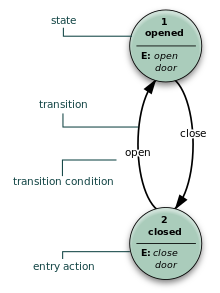

We then show through simulations that many of the neural net state machines are dynamically stable, that is, they correctly classify many long unseen strings. For a well-trained neural net, the extracted automata constitute an equivalence class of state machines that are reducible to the minimal machine of the inferred grammar. We discuss a quantization algorithm for dynamically extracting finite state automata during and after training. To do this, we must agree upon the definition of equivalent states. Second, we need a state for when button B2 is pressed.

From these observations, it seems that the key to making finite automata smaller is to recognize and merge equivalent states. Your finite state machine (FSM) should include three digital (HIGH/LOW) inputs (one each for the. All simulations were performed with random initial weight strengths and usually converge after approximately a hundred epochs of training. Merging states like this should produce a smaller automaton that accomplishes exactly the same task as our original one. We illustrate the inputs, intermediate key/value pairs, and outputs for. We present simulations that show the effect of initial conditions, training set size and order, and neural network architecture. Finite state machines (FSMs) or finite automata have been used traditionally in. We show that a recurrent, second-order neural network using a real-time, forward training algorithm readily learns to infer small regular grammars from positive and negative string training samples.


 0 kommentar(er)
0 kommentar(er)
